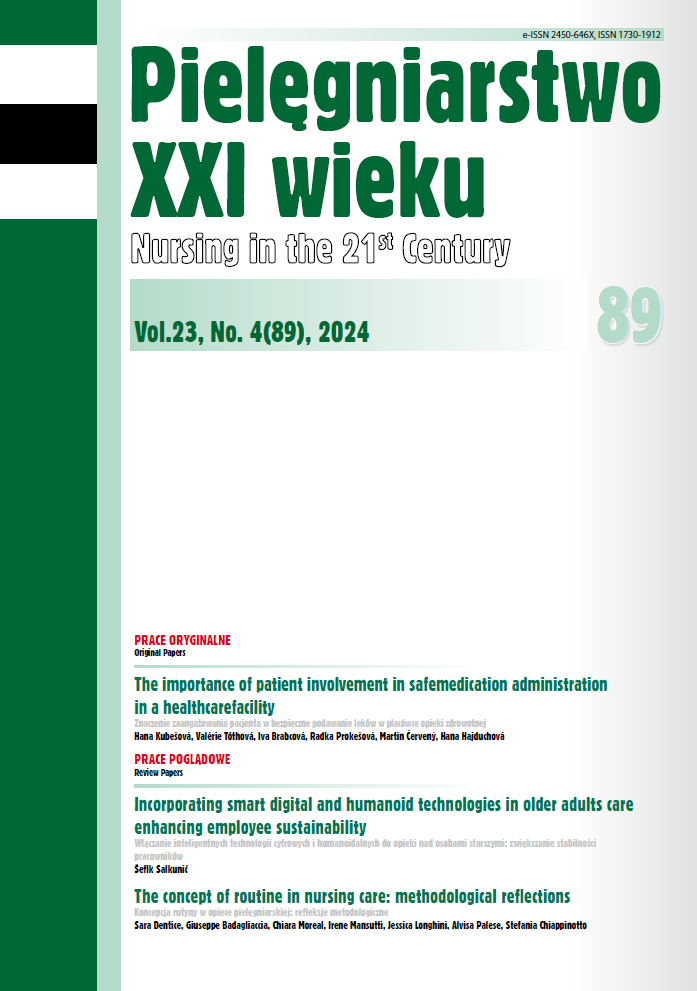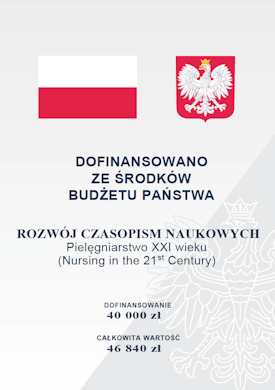Determinants of critical care nurses’ job satisfaction: A cross-sectional study including cultural validation of Kuopio University Hospital Job Satisfaction Scale
DOI:
https://doi.org/10.12923/pielxxiw-2024-0044Keywords:
job satisfaction, intensive care, critical care nursing, working conditionsAbstract
Aim. The aim of this study was to identify determinants of Polish critical care nurses’ job satisfaction and to verify the validity of Kuopio University Hospital Job Satisfaction Scale (KUHJSS) on sample of Polish critical care nurses.
Material and methods. This is a cross-sectional study using online survey method. A convenience sample of 306 nurses working in ICUs in Poland was recruited between November 2020 and July 2021. Data analysis included factor analyses, descriptive statistics, and multiple linear regression.
Results. Nurses evaluated their job satisfaction as moderate. Those who did not complete a master’s degree, were not freelancers, liked their job, and rated the quality of care more highly had higher job satisfaction. The results revealed that KUHJSS adapted to the population of Polish critical care nurses has a diff erent structure from the original scale, and is a valid and reliable tool to measure job satisfaction among this population.
Conclusions. The results support the statement that culturally dependent job characteristics impact job satisfaction levels. To improve nurses’ job satisfaction, it is important that their education refl ects actual tasks and promotes autonomy; the type of employment protects the employee; the working environment promotes person-centered approach and aff ects how nurses like their job; and the quality of care remins high.
References
1. Friganović A, Selič P. Where to look for a remedy? Burnout syndrome and its associations with coping and job satisfaction in critical care nurses-a cross-sectional study. Int. J. Environ. Res. Public Health. 2021; 18(8): 4390.
2. Dilig-Ruiz A, et al. Job satisfaction among critical care nurses: A systematic review. Int. J. Nurs. Stud. 2018; 88: 123-134.
3. Nurmeksela A, et al. Relationships between nurse managers’ work activities, nurses’ job satisfaction, patient satisfaction, and medication errors at the unit level: a correlational study. BMC Health Serv. Res. 2021; 21(1): 296.
4. Vermeir P, et al. Job satisfaction in relation to communication in health care among nurses: a narrative review and practical recommendations. Sage Open. 2017. 7(2): 2158244017711486.
5. Duffield CM, et al. A comparative review of nurse turnover rates and costs across countries. Journal of Advanced Nursing, 2014; 70(12): 2703-2712.
6. Brief AP, Aldag RJ. Employee reactions to job characteristics: A constructive replication. Journal of Applied Psychology. 1975; 60(2): 182-186.
7. Hauff S, Richter NF, Tressin T. Situational job characteristics and job satisfaction: The moderating role of national culture. International Business Review. 2015. 24(4): 710-723.
8. Młynarska A, Krawuczka A, Kolarczyk E, et al. Rationing of nursing care in intensive care units. Int. J. Environ. Res. Public Health. 2020; 17(19): 6944.
9. Borys M, et al. Job satisfaction among anesthetic and intensive care nurses – multicenter, observational study. Anestezjologia Intensywna Terapia. 2019; 2(51): 106-110.
10. Krztoń-Królewiecka A, et al. Quality of primary health care in Poland from the perspective of the physicians providing it. BMC Family Practice. 2016. 17(1): 151.
11. Weigl W, et al. Mortality rate is higher in Polish intensive care units than in other European countries. Intensive Care Med. 2017; 43(9): 1430-1432.
12. Kvist T, et al. The job satisfaction of finnish nursing staff: The Development of a Job Satisfaction Scale and Survey Results. Nursing Research and Practice. 2012; 2012: 210509.
13. Sapountzi-Krepia D, et al. Kuopio University Hospital Job Satisfaction Scale (KUHJSS): its validation in the Greek language. J. Nurs. Manag. 2017; 25(1): 13-21.
14. Ylitörmänen T, Turunen H, Kvist T. Job satisfaction among registered nurses in two Scandinavian acute care hospitals. Journal of Nursing Management. 2018; 26(7): 888-897.
15. Sanner-Stiehr E, et al. Job satisfaction and generational nursing characteristics among registered nurses in the United States, Italy and Finland: Results of a survey study. Journal of Nursing Management. 2021; 29(8): 2364-2373.
16. Niskala J, et al. Interventions to improve nurses’ job satisfaction: A systematic review and meta-analysis. J. Adv. Nurs. 2020; 76(7): 1498-1508.
17. Kofta A. Addressing the challenges of the healthcare system in Poland, in ESPN Flash Report. 2018, European Commission.
18. Kujawska J. Efficiency of healthcare systems in european countries - the dea network approach. Metody Ilościowe w Badaniach Ekonomicznych. 2018; 19(1): 60-70.
19. Kwiatkowska-Ciotucha D, Załuska U, Kozyra C. The perception of occupation by hospital nurses in Poland and Germany in terms of the risk of excessive stress and burnout as well as possible coping and preventive solutions. International Journal of Environmental Research and Public Health. 2021; 18(4): 1797.
20. Spector P. Job Satisfaction: application, assessment, causes, and consequences. California: Thousand Oaks; 1997.
21. Sousa LS, et al. Predictors of moral harassment in nursing work in critical care units. Rev. Bras. Enferm. 2021; 74(3): e20200442.
22. Kiwanuka F, et al. Nursing leadership styles and their impact on intensive care unit quality measures: An integrative review. J. Nurs. Manag. 2021; 29(2): 133-142.
23. Cicolini G, Comparcini D, Simonetti V. Workplace empowerment and nurses’ job satisfaction: a systematic literature review. J. Nurs. Manag. 2014; 22(7): 855-871.
24. Serafin L, et al. The relationship between perceived competence and self-esteem among novice nurses - a cross-sectional study. Ann. Med. 2022; 54(1): 484-494.
25. Permadi IKO, Diputra I, Sanjiwani P. The effect of work-life balance and workload on job satisfaction to affect nurse performance. EKONOMIS Journal of Economics and Business. 2023; 7: 884-891.
26. Koy V, et al. Relationship between nursing care quality, nurse staffing, nurse job satisfaction, nurse practice environment, and burnout: literature review. International Journal of Research in Medical Sciences. 2015; 3(8): 1825-1831.
27. NIPiP, Raporrt o stanie pielęgniarstwa i położnictwa w Polsce. 2023: https://nipip.pl/wp-content/uploads/2023/12/RAPORT-O-STANIE-PIELEGNIARSTWA-I-P-OLOZNICTWA-W-POLSCE-MAJ-2023.pdf.
28. Boateng GO, et al. Best practices for developing and validating scales for health, social, and behavioral research: a primer. Front Public Health. 2018; 6: 149.
Downloads
Published
Issue
Section
License
Copyright (c) 2025 Authors

This work is licensed under a Creative Commons Attribution 4.0 International License.




